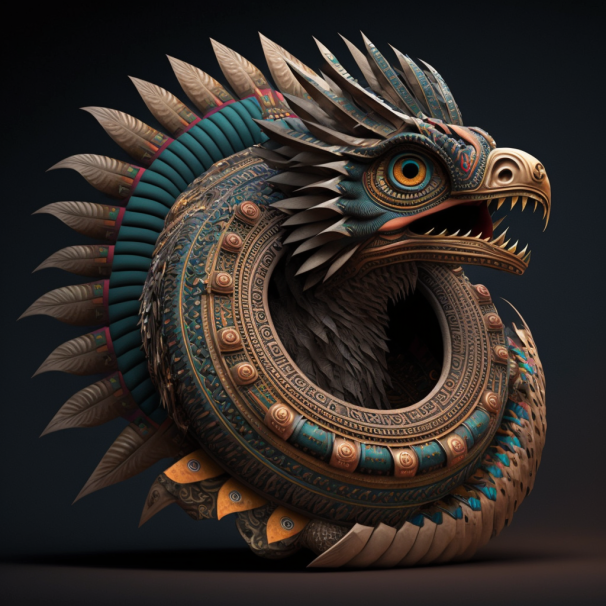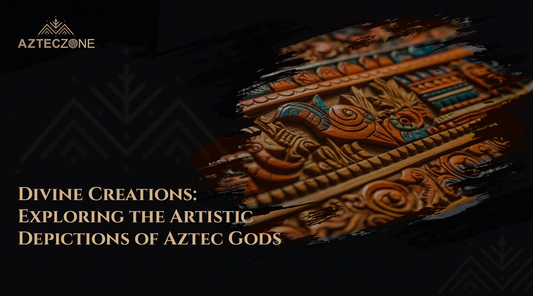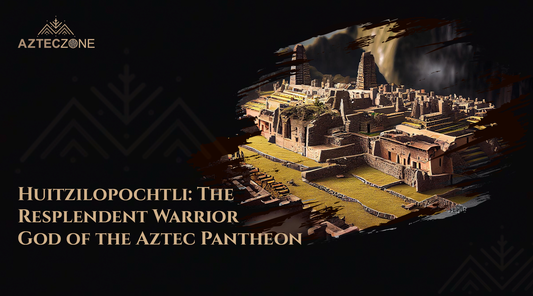A Pervasive Symbol in Mesoamerican Mythology and Culture
Tracing the Origins, Representations, and Significance of the Feathered Serpent across Ancient Civilizations
The Feathered Serpent is a potent symbol in Mesoamerican mythology, transcending time and cultural boundaries as a recurring motif in the beliefs and iconography of numerous ancient civilizations. Most famously associated with the Aztec god Quetzalcoatl, the Feathered Serpent's influence extends far beyond the Aztec realm, permeating the mythologies of the Maya, the Olmecs, and the Toltecs, among others. In this article, we delve into the origins, representations, and significance of the Feathered Serpent, examining its enduring impact on the religious, artistic, and cultural expressions of Mesoamerican civilizations.
The Origins of the Feathered Serpent
Early Representations
The Feathered Serpent can be traced back to the Olmec civilization, which flourished in the Gulf Coast region of Mexico from around 1400 to 400 BCE. Early Olmec artifacts, such as the La Venta Monument 19, display serpent imagery with hints of feather-like appendages, suggesting the beginnings of the Feathered Serpent motif. As Mesoamerican cultures evolved, the symbol continued to appear in various forms, solidifying its importance as a recurring motif in the region's mythology.
The Toltec Connection
The Toltecs, a civilization that arose in central Mexico around 900 CE, played a crucial role in the development and dissemination of the Feathered Serpent motif. The Toltec capital, Tula, featured numerous depictions of the Feathered Serpent in its architecture and art. The Toltec influence on later civilizations, particularly the Aztecs, ensured that the Feathered Serpent remained a central figure in Mesoamerican mythology and iconography.
Representations of the Feathered Serpent
Quetzalcoatl: The Aztec Feathered Serpent
The most famous incarnation of the Feathered Serpent is Quetzalcoatl, the Aztec god of creation, knowledge, and wind. Often depicted as a snake adorned with feathers or as a combination of serpent and bird-like features, Quetzalcoatl embodies the duality of nature, linking the earthly realm with the celestial.
Kukulkan: The Maya Feathered Serpent
In Maya mythology, the Feathered Serpent is known as Kukulkan, a deity associated with wind, agriculture, and the arts. Kukulkan is often portrayed as a serpent with a plumed headdress or with bird-like attributes, symbolizing the connection between the earth and the sky.
The Plumed Serpent in Other Mesoamerican Cultures
The Feathered Serpent motif appears in various forms across different Mesoamerican cultures, including the Mixtec, Zapotec, and Teotihuacan civilizations. While the specific attributes and associations of the Feathered Serpent may vary between cultures, the central theme of a serpent adorned with feathers or embodying bird-like qualities remains consistent.
The Cultural Significance of the Feathered Serpent
The Symbolism of Duality
The Feathered Serpent represents the duality of nature, symbolizing the interconnectedness of the earth and the sky. As a creature that embodies both serpent and bird-like characteristics, the Feathered Serpent bridges the gap between the terrestrial and celestial realms, reflecting the Mesoamerican worldview that emphasized the balance and harmony between opposing forces.
The Role in Creation Myths
The Feathered Serpent often plays a significant role in Mesoamerican creation myths, highlighting its importance as a creator deity and a symbol of life-giving forces. In various narratives, the Feathered Serpent is credited with the creation of the earth, the heavens, and humanity, underlining its status as a powerful and benevolent force in the cosmos.
The Connection to Knowledge and Learning
Across Mesoamerican cultures, the Feathered Serpent is frequently associated with knowledge, wisdom, and learning. This connection to intellectual pursuits demonstrates the value placed on education and the acquisition of knowledge in ancient societies. As a patron of arts, sciences, and agriculture, the Feathered Serpent represents the divine inspiration and guidance that ancient civilizations believed they received.
The Feathered Serpent is a pervasive symbol in Mesoamerican mythology and culture, embodying the duality of nature, the creative force of the universe, and the pursuit of knowledge. As a recurring motif across various ancient civilizations, including the Olmecs, Toltecs, Aztecs, and Maya, the Feathered Serpent highlights the interconnectedness of Mesoamerican cultures and their shared belief systems. By exploring the origins, representations, and significance of the Feathered Serpent, we can gain a deeper understanding of the rich and complex mythologies that shaped the religious, artistic, and cultural expressions of the ancient peoples of Mesoamerica.




